Westoning Garden City
Bedfordshire Times 4 March 1927
(The following is a copy of an article taken from the newspaper above)
A HILL DIFFICULTY
Sampshill (Westoning) as a Garden City...Where Bunyan was arrestedA proposal to construct a garden city at Westoning, to remove a steep hill and to build a new passenger and goods station on the L.M.S. railway, came before Ampthill Rural District Council at its meeting on Thursday. Mr. G.E. Brown presiding.
The proposed site is at Sampshill, where John Bunyan was arrested, and the hill which it is proposed to remove, judging from the opinion of the development company director as expressed in the letter below may well have been in Bunyans mind when he pictured the 'Hill Difficulty' of 'The Pilgrims Progress.'
The following letter was addressed to the council by Mr. W.B. Ropkins of Westoning as Governing Director of the Gaius Estates and Building Society, Limited whose chief offices are in Westoning.
"I wish to call the attention of your Council to the following facts; Sampshill, in the parish of Westoning, within the county of Bedford, and within your area is a hill which rises 0.75 of an inch in each 6 inches, and is obviously a very difficult hill, even to walk up, for wheeled traffic it has a bad name, and is terrible for horse-flesh and a bugbear to all the agriculturists in the neighbourhood. Indeed, it would be interesting to hear what the R.S.P.C.A. would like to say about it. Quite seriously, though, its rise is a very serious matter for those who attempt to work it. There is no alternative but to remove the hill bodily and substitute for it an easier gradient.
The Company's plans are as follows
'I have recently purchased on behalf of my Company as above the whole of the area of Sampshill where I have commenced laying out the whole of it as the Westoning Garden City, on modern up-to-date lines. Plans have been prepared by Mr. Walker and are now in my offices here which show the whole layout, including the provision of an excellent passenger and goods station on the main line of the L.M.S. railway, the roadway approach to which will be along the side of the footpath leading alongside the Railway.
It is not right that my Company should bear the whole of the outlay, which will be incurred in the formation of this suite, and the passenger and goods station, but, as this is a case of need, I shall not shrink from this if it is forced upon me, as in the interests of the New Garden City it has to be done and done quickly.
I shall therefore be glad if you will, with your Council, please give the whole subject your careful consideration and let me have your decision at the earliest date possible, as this is of the utmost importance for the carrying out of my plans in their entirety.
The Chairman: I think you had better refer this letter to the Highways Committee and let them report on it
Mr. R.N. Attwood: What does he want us todo?
Mr. G.H.Taylor: To remove a hill.
Mr. R.N.Attwood: He saw the hill was there before he bought the estate didn't he? (Laughter)
The Chairman's suggestion was agreed to.
(Editor: - Just how far this building development proposal of houses and railway station for Westoning in 1927 by Mr. W.B. Ropkins was pursued is, at the present time, not known but enquires at the Mid-Beds Planning /Highways Department Offices are still being made. August 2002. The idea of a Garden City suggests that Mr. Ropkins had been greatly influenced by the work that had then gone on recently at Letchworth (1903) and Welwyn (1919).)
The above proposal for a railway station at Westoning was not the first; for as the result of anecdotal information obtained during recent conversations with local residents, it is considered that the Lord of the Manor at the time at Westoning (1840-93), the Rev Campion, was against the building of a railway station at Westoning. It was has been suggested that through his opposition to such a scheme a station was built instead at Flitwick in 1870 when the L.M.S. Railway line was originally laid in 1867.
In conclusion it can therefore now be appreciated, when one looks around present day Bedfordshire, that if the developments stated above had taken place to their fullest extent, then there would have to have been significant changes within the Parish of Westoning that we know today.
